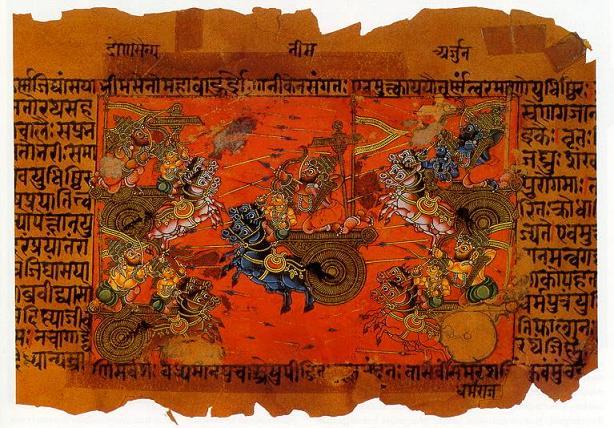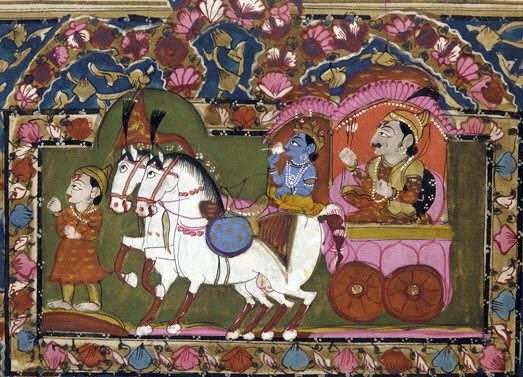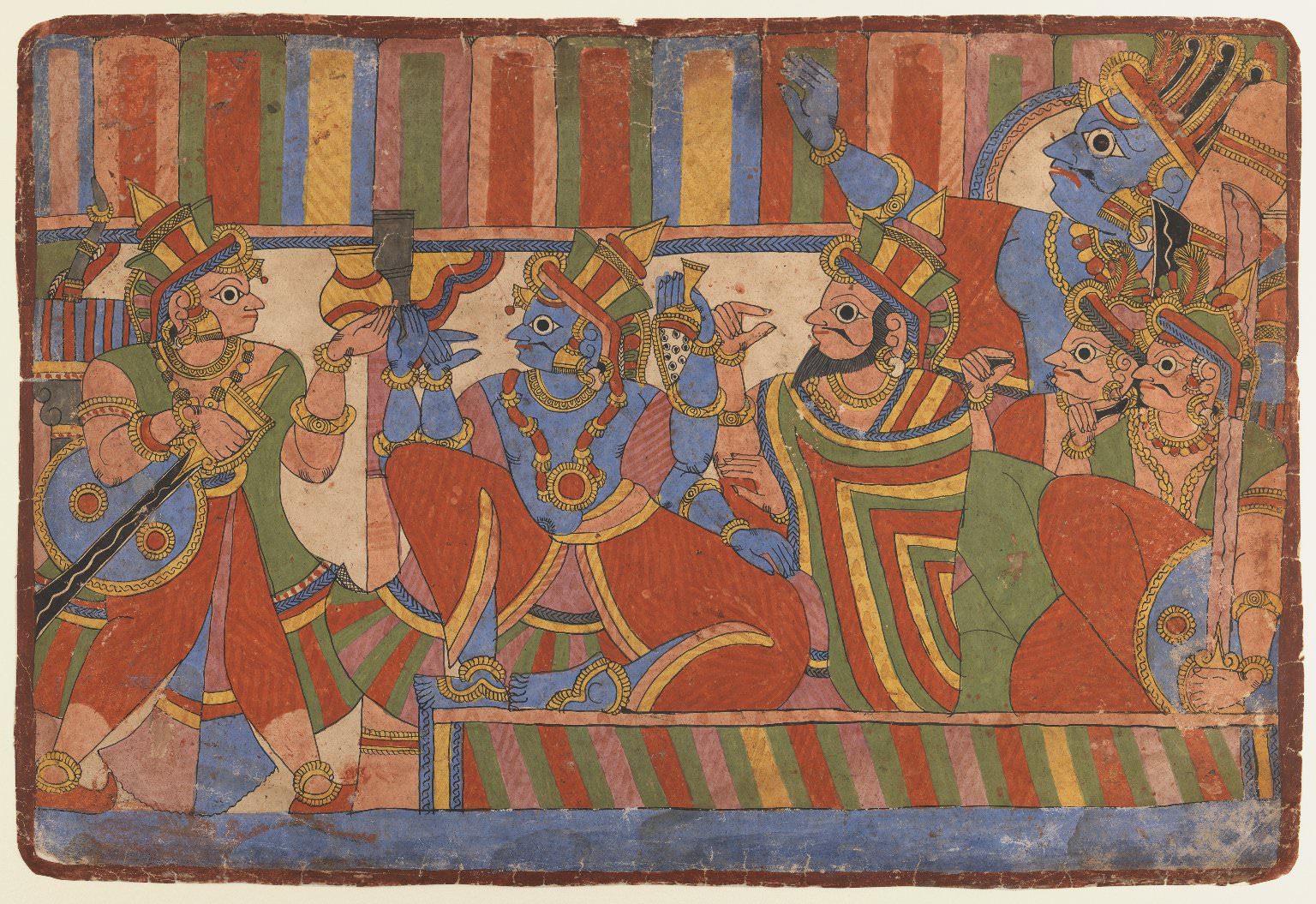
Nell Shapiro Hawley ‘11, a scholar of the Mahābhārata and its early iterations in Sanskrit poetry and drama, is the Preceptor in Sanskrit in the Harvard University Department of South Asian Studies and current Ph.D candidate in South Asian Languages and Civilizations at the University of Chicago. She recently released a new book, Many Mahābhāratas (SUNY Press), which she co-edited with Sohini Sarah Pillai. The volume is an introduction to the spectacular and long-lived diversity of Mahābhārata literature in South Asia. The Mahābhārata, with roughly 75,000-100,000 verses, is the longest epic poem known. The Mittal Institute sat down with Nell to learn more about her research, and the importance of the book to the landscape of South Asian literature.
Mittal Institute: Nell, congratulations on your new book! Can you share with our community an overview of the volume, and what readers can expect the book to cover?
Nell Shapiro Hawley: Thank you! Before I begin, let me admit that when it comes to the Mahābhārata, the very notion of “overview” presents a challenge. The epic is monumental in itself, and it’s all the more so when you account for its ever-expanding body of retellings. But that’s precisely why we undertook this project. We wanted to paint an expansive, thoughtful picture of this many-faced work in a single volume. The result, I hope, is an honest and satisfying answer to a basic question that students of Hinduism and South Asia have been asking for a long time: What is the Mahābhārata?
Readers may come to the book thinking of the Mahābhārata as the famous Sanskrit epic that tells the story of a brutal war between the Pāṇḍavas and the Kauravas—cousins and enemies. Perhaps we think of it as a penetrating exploration of Dharma. Or maybe we think of it as the narrative frame of the Bhagavad Gītā, a momentous section of Book Six that is known across the world as a vital part of Hindu scripture. The book confirms all that. But when we look at the epic from the perspective of its countless retellings—the “many Mahābhāratas” that fill South Asia’s languages and art forms—we discover its true capaciousness.

Nell Shapiro Hawley. Image by Serena Shah ’21.
The Mahābhārata, it turns out, tells a coming-of-age story (Many Mahābhāratas chapter 15). It undermines seemingly entrenched ideas about gender (chapters 4, 8, 16) and caste (chapter 17). It offers an unblinking study of genocidal rage (chapter 2). It dives deep into character (chapters 3 and 5). It reframes villains as heroes (chapter 9). It laughs at what we mistakenly believe to be important (chapter 7). It’s poetry (chapters 6 and 10) and performance (chapters 8 and 12). It is deeply Hindu (chapter 13), but also Jain (chapter 11). It tells the story of the past (chapter 14) and the story of the future (chapter 18). All of this unfolds in ten different languages—Sanskrit, Malayalam, Hindi, Kannada, Telugu, Apabhramsha, Tamil, Bengali, Oriya, and English—and in a kaleidoscope of creative formats. That’s why we argue in the introduction that the Mahābhārata tradition is more than a collection of texts–composed, performed, painted, and so on. Instead, it is a transmedial, transhistorical, translinguistic, and transdisciplinary mode of expression in South Asia. As the scholar A. K. Ramanujan once said of the Rāmāyaṇa, the Mahābhārata’s sister epic, we ought to speak of these traditions as genres in themselves.
Because the Mahābhārata revolves around a bloody fratricidal war, some consider it inauspicious to possess the whole thing in written form, or to read it inside the house, or indeed to embark on any endeavor that takes on the entire narrative from beginning to end. (A famous example: The eleventh-century poet Nannaya attempted to compose a whole Mahābhārata, beginning to end, in Telugu; he died partway through.) Our volume escapes the curse, so to speak, by exploring but a tiny fraction of extant Mahābhāratas. Rather than attempt a comprehensive study, we aim to encourage in the reader a sense of discovery.
We organized the volume into four sections that reflect a roughly chronological progression. The first section, “The Manyness of the Sanskrit Mahābhārata,” roots the diversity of the Mahābhārata narrative tradition in the multivocality of the Sanskrit epic itself. The second, “Sanskrit Mahābhāratas in Poetry and Performance,” investigates a sweep of Mahābhāratas in Sanskrit literature, most of which emerge in the first and early second millennium. Two of the chapters in this section study Sanskrit Mahābhāratas that continue to be performed today—partially in languages beyond Sanskrit. What’s old is new!
The third section, “Regional and Vernacular Mahābhāratas from Premodern South Asia,” captures poignant, often understudied moments in the Mahābhārata’s path from 800–1800 CE. The essays in this section examine Mahābhāratas in Hindi, Kannada, Tamil, Telugu, and Apabhramsha. The final section, “Mahābhāratas of Modern South Asia,” explores representations of the Mahābhārata that engage with the social, political, and aesthetic concerns of modern South Asia. Here is a classical text that constantly breaks new ground.
That’s why we argue in the introduction that the Mahābhārata tradition is more than a collection of texts–composed, performed, painted, and so on. Instead, it is a transmedial, transhistorical, translinguistic, and transdisciplinary mode of expression in South Asia. As the scholar A. K. Ramanujan once said of the Rāmāyaṇa, the Mahābhārata’s sister epic, we ought to speak of these traditions as genres in themselves.
Mittal Institute: Walk us through the editing process – what did that entail?
Nell Shapiro Hawley: No single scholar could have written this book—there are simply too many languages, genres, historical periods, and disciplinary approaches involved. Rather, the project had to be collaborative, and that turned out to be the most rewarding side of it. Editing is serious work. Over a period of three years I was in close conversation with some of the most brilliant minds in the field, working with them to balance the virtues of originality, research, and argument with an editor’s ever-present concern: accessibility. The authors were writing for the most part about Mahābhāratas that might be unfamiliar to modern readers—certainly to the general reader in the West. Many of their Mahābhāratas had never been translated into English. We had to make sure that an interested undergraduate would be able to take it all in, but we needed to do this without ever compromising the virtuosity of the authors’ research. My knowledge of the Mahābhārata tradition—and the history of South Asia, in turn—grew by leaps and bounds in the course of doing that work.
Mittal Institute: How did you first become interested in the Mahābhārata?
Nell Shapiro Hawley: I met the Mahābhārata when I was a first-year student in the College and taking Elementary Sanskrit. At the end of the year we read a few chapters from the battle books—that is, the books in the middle of the epic that narrate the eighteen days of incredibly bloody combat at Kurukṣetra. We read the story of how Droṇa, the Kauravas’ and the Pāṇḍavas’ senior teacher, is killed in battle. I won’t go into the details, but in true Mahābhārata fashion, the scene is high-drama—ethically, emotionally, visually. What a world! I wanted to dive in.

Krishna and Arjuna at Kurukshetra, 18th–19th-century painting, at the Smithsonian Freer Sackler Gallery. Wikipedia Commons.
The following year I took a course with Emily Hudson, who was then teaching in History and Literature, on the Mahābhārata. Early in the epic there is a famous scene in which the protagonists, the Pāṇḍavas, lose their kingdom, themselves, and their (shared) wife, Draupadī, to their cousins in a game of dice. The dice game opens up a kind of chasm into which everyone and everything falls, resulting in the great war and its bitter aftermath. The whole Mahābhārata is a masterpiece, but the chapters that narrate the game of dice are extraordinary. Every student of literature, period, should read those chapters. Studying the dicing scene with Emily was a gift because when you see it through her eyes, you learn how the text “shows” rather than “tells.” You feel every point of tension. After that, I wanted to hold on to the Mahābhārata for life. Every time I read that part of the epic again, I find something new. I also feel something new, which is maybe even more important.
Mittal Institute: Scholars estimate that the Mahābhārata was composed between 300 BCE and 300 CE. What lessons or teachings from this ancient text are still relevant in today’s world?
Nell Shapiro Hawley: The world that the Mahābhārata depicts—and here I speak of the Sanskrit epic version of two thousand years ago—is very much our world. We may not encounter celestial weapons, powerful curses, or deities roaming around in disguise every day. (Or maybe we do, in our own ways.) But do we not find violence, overconfidence, and toxic masculinity everywhere we look? Do we not struggle with deep, perhaps unanswerable questions about how we ought to live our lives? We still fail to listen to those deemed unworthy of hearing—women, anyone not born into privilege, and very importantly the animals and forests around us. The epic itself doesn’t silence them, but often its characters do—and so do we. The Mahābhārata holds up a mirror to all of this.
The epic is realistic about many things, but I think the side of human life that it depicts with greatest honesty is this shattering truth: answers to difficult questions never come easily. In fact they may never come at all. And to complicate things further, thinking does not always lead to an answer, either. We see in the Mahābhārata that when characters arrive at points of great struggle, it may not help to learn a philosophical concept, recount an ethical lesson, or hear an old story. In general—and I hesitate to say this in a Harvard context—intellectualizing doesn’t help. What ultimately moves things forward are emotions—the characters’ desires, their suffering, their attachments to others.
This becomes very clear at the end of the epic, when Yudhiṣṭhira, the central figure, reaches heaven only to discover that his beloved friends and relatives are not there with him. Throughout the epic he is deeply thoughtful, stoic, reluctant to exercise power; the only emotions we really see him express are grief and guilt. But in heaven he says: I want to see my loved ones. In other words, he finally expresses desire. Only then do we find a hint of resolution in the story. The Mahābhārata understands the power of emotional intelligence.

Mittal Institute: You also teach a number of Sanskrit classes at Harvard. You have a unique approach to language learning – can you elaborate on that?
Nell Shapiro Hawley: It is wonderful when students bring Sanskrit (hardly a “dead language”!) to life in class. I find that this happens the most naturally when we do a lot of communicative, interactive work in the classroom. Students work together to interpret texts or compose texts of their own, they recite poetry, they talk to one another. They do a lot of activities in pairs or small groups. In this way my courses are strongly influenced by modern language teaching methods.
Sanskrit is an extremely complex language. It’s famously difficult to learn. But when students spend most of a given class session in conversation with one another, it creates a safe environment for them to experiment, think through problems creatively, and make mistakes. This makes Sanskrit a bit less intimidating. Another benefit of constant communication in class is that it prompts students to articulate why they are making the interpretive choices they are making. Students have to explain their thought processes to their peers. This helps them to recognize the skills they are building, which in turn helps them to see that learning Sanskrit is a matter of cultivating practical skills, not having mysterious “natural” talents. When students come to see one another as teachers—and themselves as teachers—the whole language becomes much more accessible.
Mittal Institute: The Mittal Institute was thrilled to contribute to part of your work via a previous faculty grant. How has your alignment with the Mittal Institute benefitted your research?
Nell Shapiro Hawley: I’m very grateful for these Mittal Institute grants, which did so much to support the book during the final stages of publication. Beyond that, the Institute has been a wonderful resource for building community among scholars of South Asia on campus. Its events draw students from all parts of Harvard—a great thing. I look forward to attending more events this year—and imagine: in person!
